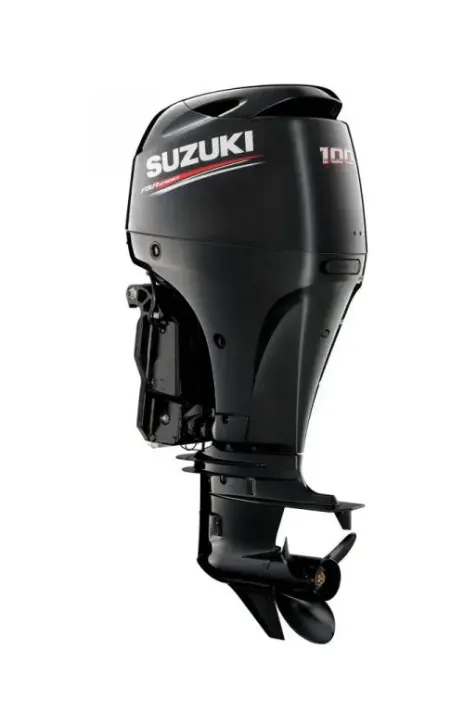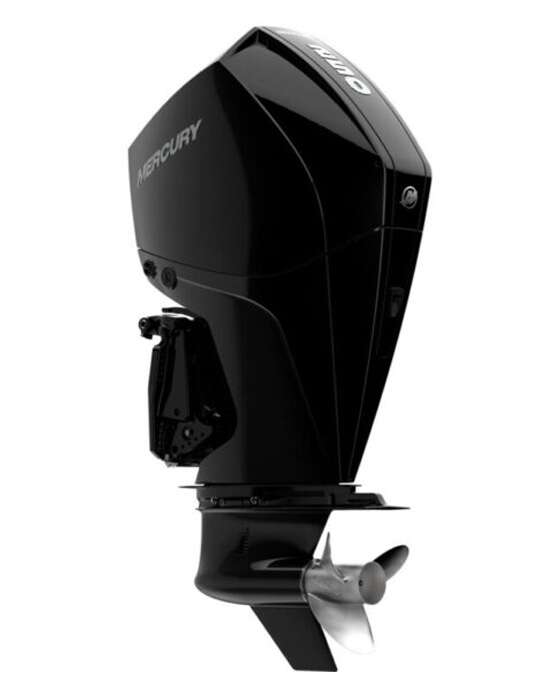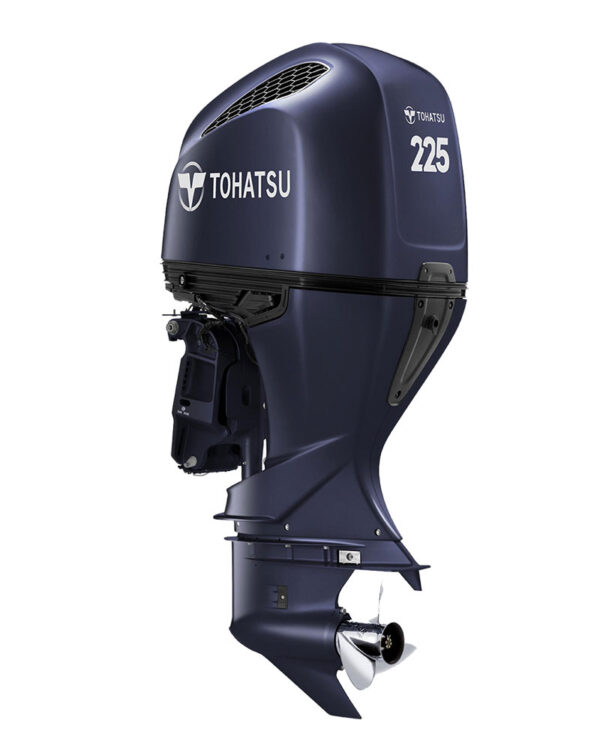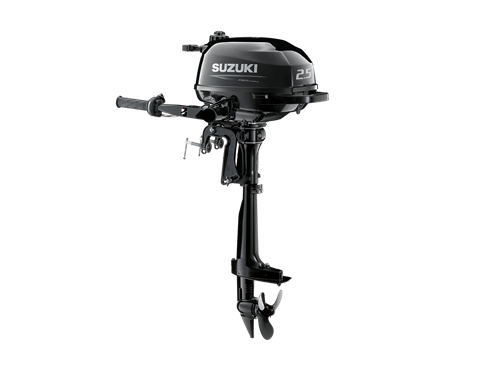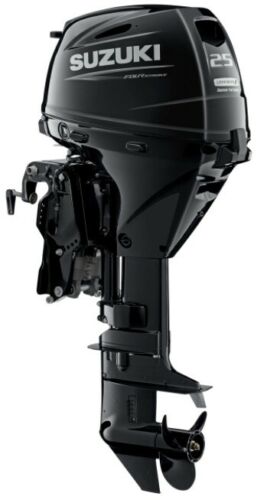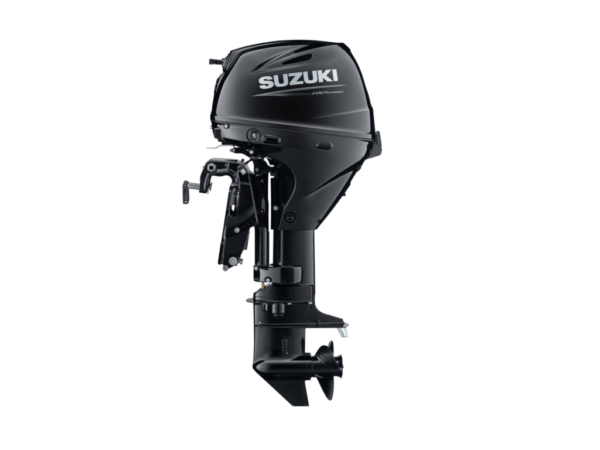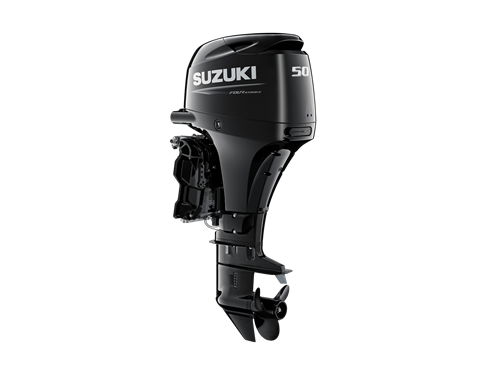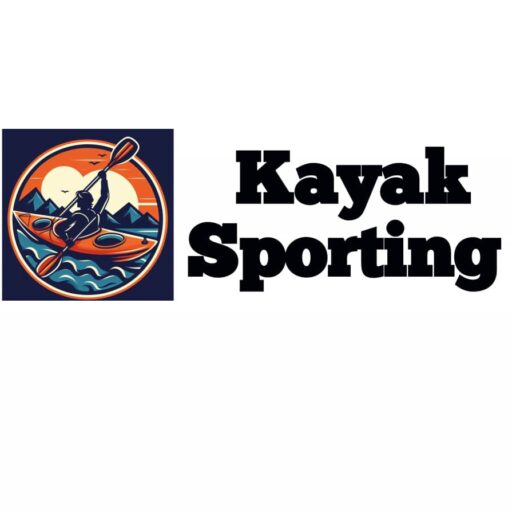POWERING MORE THAN THE BOAT
Our Top Outboard Motors Categories
checkout our top notch Outboard motors for sale !
At kayak Sporting Outboard motor shop, we never compromise when it comes to safety. For every motor we sell, we conduct a compression test, as well as a test run in our water tank. Our staff will take you through how to operate every facet of your new outboard motor so you can embark on your next boating adventure with confidence
All Outboard Motors
- Outboard Motors
Buy New Mercury V6 225 XL DS Black 225hp 4 Stroke Outboard Power Tilt 209 CID motor for sale
23568 $ Add to cartRated 0 out of 5Add to WishlistAdd to Wishlist - Outboard Motors
Buy Tohatsu 225hp 4 Stroke Outboard BFT225A XA Power Tilt Engine online
19587 $ Add to cartRated 0 out of 5Add to WishlistAdd to Wishlist - Outboard Motors
Buy Tohatsu 250hp BFT Outboard BFT250A XA Power Tilt 4 Stroke Engine online
20963 $ Add to cartRated 0 out of 5Add to WishlistAdd to Wishlist - Outboard Motors
NEW TOHATSU MFS 15EPS (DISPLAY STOCK, WATER TESTED FOR 10 MINS ) Outboard Motors
Rated 0 out of 52950 $Original price was: 2950 $.2499 $Current price is: 2499 $. Add to cartAdd to WishlistAdd to Wishlist - Outboard Motors
SUZUKI DF2.5S 2.5HP SHORT SHAFT OUTBOARD ENGINE
675 $ Add to cartRated 0 out of 5Add to WishlistAdd to Wishlist - Outboard Motors
SUZUKI DF20 AS & ALL MODELS OUTBOARD ENGINE
Rated 0 out of 52950 $Original price was: 2950 $.2850 $Current price is: 2850 $. Add to cartAdd to WishlistAdd to Wishlist - Outboard Motors
SUZUKI DF25AS / ATL SHORT AND LONG SHAFT OUTBOARD ENGINE
Rated 0 out of 54001 $Original price was: 4001 $.3499 $Current price is: 3499 $. Add to cartAdd to WishlistAdd to Wishlist - Outboard Motors
SUZUKI DF30ATS / ATL 30HP SHORT AND LONG SHAFT OUTBOARD ENGINE
Rated 0 out of 55401 $Original price was: 5401 $.4999 $Current price is: 4999 $. Add to cartAdd to WishlistAdd to Wishlist - Outboard Motors
SUZUKI DF40AT 40HP LONG SHAFT OUTBOARD ENGINE
5600 $ Add to cartRated 0 out of 5Add to WishlistAdd to Wishlist - Outboard Motors
SUZUKI DF4A 4HP LONG AND SHORT SHAFT OUTBOARD ENGINE
Rated 0 out of 51200 $Original price was: 1200 $.1080 $Current price is: 1080 $. Add to cartAdd to WishlistAdd to Wishlist
WHAT IS AN OUTBOARD MOTOR & HOW DOES IT WORK?
Whether you’re new to the world of boating or are an experienced enthusiast, you’ll hear terms like outboards, powerheads, tiller and skeg used quite often. But what do all of these words mean, and how do they relate to one another?
Outboard motors are commonly used in the marine industry, and it’s important to understand how all of their different parts work together. Keep reading to learn all about the anatomy of a marine outboard motor and how this knowledge can apply to a career as a marine technician.1.
What Is an Outboard Motor?
An outboard motor is a propulsion system for boats and is one of the most common motorized methods for propelling watercraft.
Unlike inboard motors, this type of motor is designed to be installed to the outside of the transom, or outside the boat—which leaves more room in the interior of the boat. Benefits of outboard motors include a high horsepower to weight ratio, ease of installation and maintenance and extended maintenance intervals.
An important thing to know about outboard motors is that they come in two different versions: 2- and 4-stroke. In the past, the differences between these two models were more significant. However, thanks to advancements in technology, modern-day 2- and 4-stroke motors are much more comparable in reliability, weight, speed and fuel economy.
Breaking Down the Parts of an Outboard Motor
Outboard motors consist of three main sections. These include:
- Top (outboard powerhead)
- Mid-section
- Outboard lower unit
The top half of the engine contains the outboard powerhead, which is made up of several different components. The mid-section refers to the middle part of the engine, and the outboard lower unit is located below.
Let’s take a closer look at each of these sections and how they work.
Outboard Powerhead
The top section of an outboard motor, or the outboard powerhead, is composed of various components that make up a combustion engine. It houses the engine block, cylinder heads, pistons and valves that make the engine run.
Essentially, the powerhead is made up of the bare bones of the engine, which include the following components:
- Engine block: The engine block is where the moving components of the engine are located, which include the piston rods, pistons and the crankshaft. It also contains the cylinders, which is where the pistons are. The strokes of the engine happen inside of the engine block and vary based on whether it’s a 2- or 4-stroke motor.
- Crankshaft: Pistons attach to the crankshaft inside of the engine block. As the pistons move up and down, the crank spins around them to generate power. Piston rods connect the piston to the crank, and as the crankshaft spins around, the piston rods move up and down to move the pistons inside of the cylinders.
- Cylinder heads: Above the cylinders, you’ll find the cylinder head—another part that makes up the engine block. Depending on if it’s a 2- or 4-stroke engine, this area houses the camshafts, spark plugs, cams and valves.
Together, these components make up the main part of the powerhead.
Another important element to note are cooling passages, which are integrated into the engine block, cylinders and cylinder heads. Essentially, these are channels that allow water that absorbs heat to flow through the powerhead. This makes it so that the engine doesn’t overheat to a point where metals can melt.
In order to regulate the temperature of the water flowing through the engine, there is a thermostat located in the cooling passages. The thermostat’s job is to ensure the engine is neither too hot or cold, which can both create issues.
Mid-Section
The mid-section of an outboard motor is a metal casing designed to connect the engine to the lower unit. Its main function is to act as a channel for connecting the components of the engine with those in the lower unit.
This section includes a bracket, which attaches the motor to the transom of the boat. This allows for the engine to turn different directions and for the boat to be steered.
On smaller boats, you will typically find a tilt mechanism that makes it possible to lift the engine out of the water. On larger outboards, and some smaller ones, there is an electric motor that lifts the engine up and down with the simple press of a button.
In the mid-section you’ll also find the driveshaft housing, which serves as the main structural piece of the engine. This includes a water tube that connects to the lower unit and transfers cooling water to the powerhead. This area also houses the driveshaft, which sends rotation and torque to the lower unit, where the propeller is located.
In a nutshell, the mid-section connects the powerhead and lower unit and is what attaches the motor to the boat.
Outboard Lower Unit
Similar to the powerhead, the outboard lower unit has a lot of moving parts.
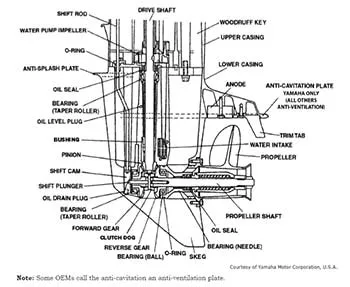
The outboard lower unit sits under the water and contains various components, including:
- Shift mechanisms
- Driveshaft
- Propshaft
- Gear set
- Clutch dog
- Bearings
- Seals and shims
Shift mechanisms control the rotation of the propeller. The lower unit of an outboard contains mechanical and non-mechanical shift mechanisms. Mechanical shift mechanisms include a vertical cam, a horizontal cam, and a yoke and cradle (BRP). The non-mechanical shift mechanisms include an electric shift, a hydroelectric shift, or a hydro-mechanical shift mechanism
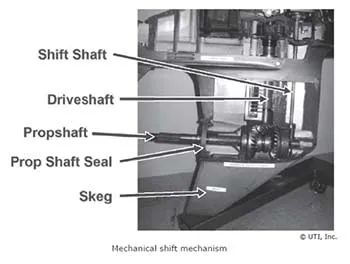
The gears in the lower unit transmit rotational force by applying force against the teeth of another gear. In an outboard lower unit, they turn the engine’s output torque 90 degrees to drive the propshaft.
The image below shows the three gears located in the lower unit of an outboard: a pinion gear, reverse gear and a forward gear. These gears transmit forces that produce different speeds, torques and directions from the power source.
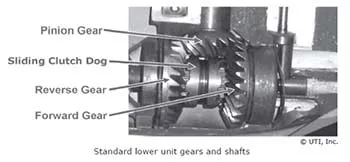
Mechanisms for Steering
When it comes to outboard motors, you’ll often hear the terms skeg and tiller.
The skeg is the lowest point on an outboard motor (pictured above). It acts as a precise rudder, which allows your boat to turn safely and effectively. It also protects the propeller from getting caught in debris in the water or other hazards the boat may come in contact with.
The tiller also plays an important role in steering the boat. This is a lever that is attached to a rudder post that can be used by the driver to steer the boat.

